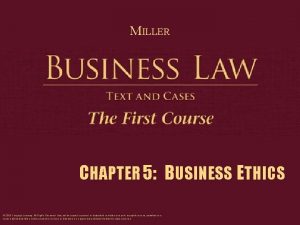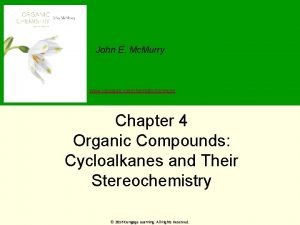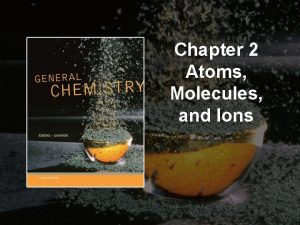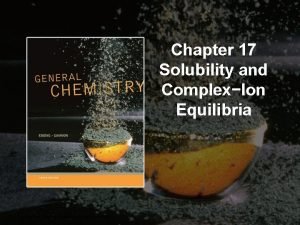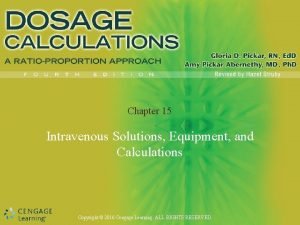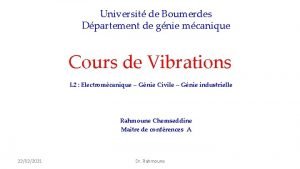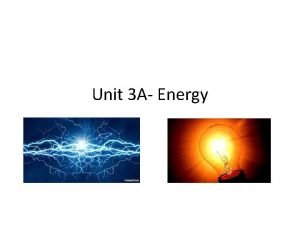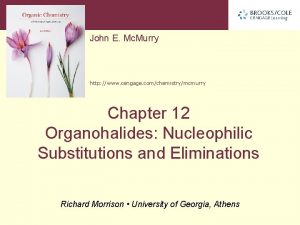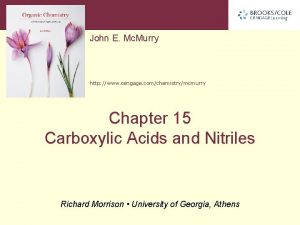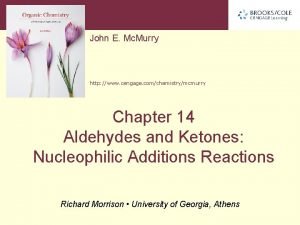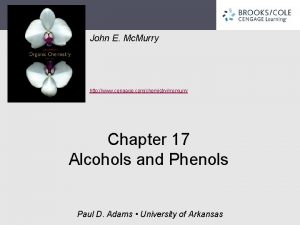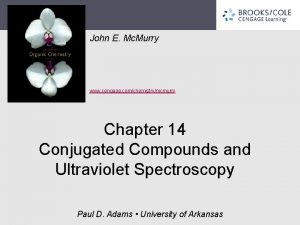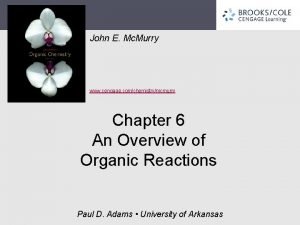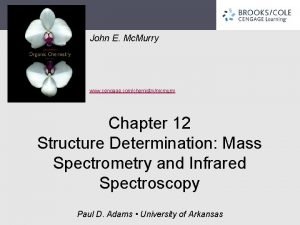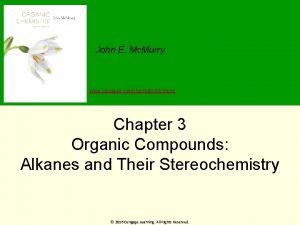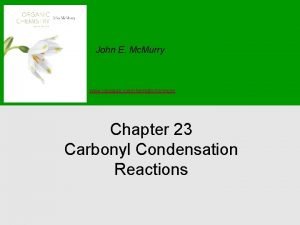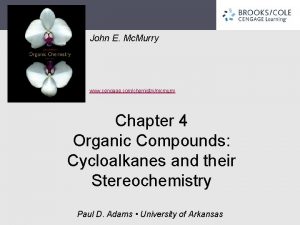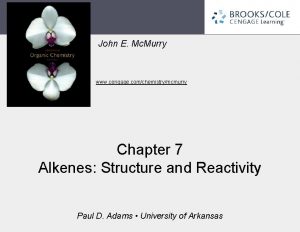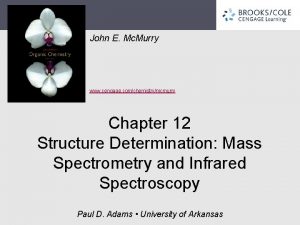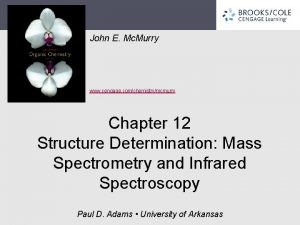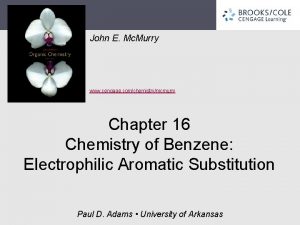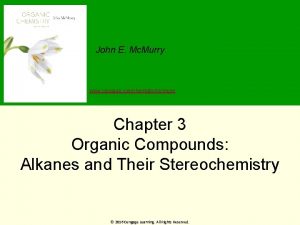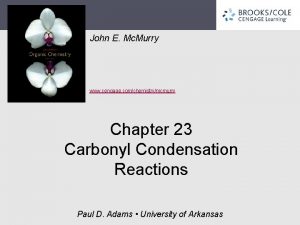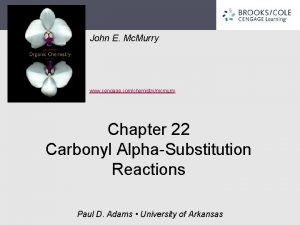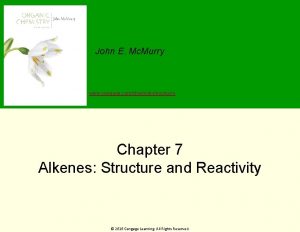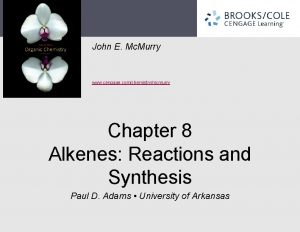John E Mc Murry http www cengage comchemistrymcmurry










































































































- Slides: 106

John E. Mc. Murry http: //www. cengage. com/chemistry/mcmurry Chapter 13 Alcohols, Phenols, and Thiols; Ethers and Sulfides Richard Morrison • University of Georgia, Athens

Alcohols, Phenols, and Ethers • Organic derivatives of water in which one or both of the water hydrogens is replaced by an organic group: H-O-H versus R-O-H, Ar-O-H, and R-O-R’ Thiols and sulfides • Corresponding sulfur analogs, R-S-H and R-S-R’

Alcohols, Phenols, and Ethers The names alcohol and thiol are restricted to compounds that have their –OH or –SH group bonded to a saturated, sp 3 -hybridized carbon atom • Phenols and thiophenols are compounds with their –OH or –SH bonded to an aromatic ring • Enols and enethiols are compounds with the –OH or –SH bonded to a vinylic, sp 2 -hybridized carbon

Alcohols occur widely and have many industrial and pharmaceutical applications • Methanol is one of the most important of all industrial chemicals • Called wood alcohol because historically it was prepared by heating wood in the absence of air • Approximately 1. 3 billion gallons are manufactured each year in the United States by catalytic reduction of carbon monoxide with hydrogen • • Toxic to humans Industrially used as a solvent and as a starting material for production of formaldehyde (CH 2 O) and acetic acid (CH 3 CO 2 H)

Alcohols • Ethanol was one of the first organic chemicals to be prepared and purified • • Ethanol production by fermentation of grains and sugars has been carried out for about 9, 000 years Its purification by distillation goes back at least as far as the 12 th century Today, approximately 4 billion gallons are produced each year in the United States through the fermentation of corn, barley, and sorghum Ethanol for nonbeverage use as a chemical intermediate is obtained by acid-catalyzed hydration of ethylene • Approximately 110 million gallons are produced each year in the United States

Phenols • Phenols occur widely in living organisms and are intermediates in the industrial synthesis of products as diverse as adhesives and antiseptics • • • Phenols are general disinfectants found in coal tar Methyl salicylate is a flavoring agent found in oil of wintergreen Urushiols are the allergenic constituents of poison oak and poison ivy • The word phenol is the name both of a specific compound and of a class of compounds

Ethers • Diethyl ether has a long history of medicinal use as an anesthetic and industrial use as a solvent • Anisole is a pleasant-smelling aromatic ether used in perfumery • Tetrahydrofuran (THF) is a cyclic ether that is often used as a solvent • Thiols and sulfides are found in various biomolecules

13. 1 Naming Alcohols, Phenols, and Thiols Alcohol classifications • Depends on the number of organic groups, R, bonded to the hydroxyl-bearing carbon • • • Primary (1º) alcohol contains –OH group on carbon atom that is bonded to one R group Secondary (2º) alcohol contains –OH group on carbon atom that is bonded to two R groups Tertiary (3º) alcohol contains –OH group on carbon atom that is bonded to three R groups

Naming Alcohols, Phenols, and Thiols Simple alcohols are named in the IUPAC system as derivatives of the parent alkane, using the suffix – ol: 1. Select the longest carbon chain containing the hydroxyl group, and derive the parent name by replacing the –e ending of the corresponding alkane with –ol • The –e is deleted to prevent the occurrence of two adjacent vowels 2. Number the alkane chain beginning at the end nearer the hydroxyl group

Naming Alcohols, Phenols, and Thiols Number the substituents according to their position on the chain, and write the name, listing the substituents in alphabetical order and identifying the position to which the –OH is bonded 3. • In the case of cis-cyclohexane-1, 4 -diol the final –e of cyclohexane does not need to be deleted because the next letter (“d”) is not a vowel

Naming Alcohols, Phenols, and Thiols Some alcohols have common names that are accepted by IUPAC Phenols are named as described in Section 9. 1 for aromatic compounds Thiols, also called mercaptans, are named using the same system as for alcohols, with the suffix –thiol in place of –ol • The –SH group is sometimes referred to as the mercapto group

13. 2 Properties of Alcohols, Phenols, and Thiols Alcohol and phenols have nearly the same geometry around the oxygen atom as water • The C-O-H bond angle is approximately tetrahedral (108. 5º in methanol) • Thiols have a more compressed C-S-H bond angle (96. 5 º in methanethiol) • The oxygen atom is sp 3 -hybridized Alcohols and phenols, like water, have higher boiling points than might be expected because of hydrogen bonding Thiols do not typically form hydrogen bonds because sulfur is not sufficiently electronegative

Properties of Alcohols, Phenols, and Thiols Alcohols and phenols, like water, are both weakly basic and weakly acidic • As weak bases are reversibly protonated by strong acids to yield oxonium ions, ROH 2+

Properties of Alcohols, Phenols, and Thiols • As weak acids dissociate slightly in dilute aqueous solution • Donating a proton to water, generating H 3 O+ and an alkoxide ion (RO-) or a phenoxide ion (Ar. O-)

Properties of Alcohols, Phenols, and Thiols • The strength of any acid HA in water can be expressed by an acidity constant, Ka • Compounds with a smaller Ka and larger p. Ka are less acidic • Compounds with a larger Ka and smaller p. Ka are more acidic • Both phenols and thiols are substantially more acidic than water

Properties of Alcohols, Phenols, and Thiols Alcohols are weak acids • Do not react with weak bases such as amines or bicarbonate ion • React only to a limited extent with metal hydroxides such as Na. OH • React with alkali metals and with strong bases such as sodium hydride (Na. H) and sodium amide (Na. NH 2) • Alkoxides are bases that are used as reagents in organic chemistry

Properties of Alcohols, Phenols, and Thiols Reactions that produce alkoxides

Properties of Alcohols, Phenols, and Thiols • • Phenols and thiols are more acidic than alcohols • Both are soluble in dilute aqueous Na. OH • Can often be separated from a mixture by basic extraction into aqueous solution, followed by reacidification Phenols are more acidic than alcohols because the phenoxide anion is resonance-stabilized • Delocalization of the negative charge over the ortho and para positions of the aromatic ring results in increased stability of the phenoxide anion • ∆Gºdissociation lower for phenols than for alcohols

Properties of Alcohols, Phenols, and Thiols • Phenols with an electron-donating substituent are less acidic because these substituents concentrate the charge • Phenols with an electron-withdrawing substituent are more acidic because these substituents delocalize the negative charge • The acidifying affect of an electron-withdrawing substituent is particularly noticeable in phenol with a nitro group at the ortho or para position

Worked Example 13. 1 Predicting the Relative Acidity of a Substituted Phenol Is p-hydroxybenzaldehyde more acidic or less acidic than phenol?

Worked Example 13. 1 Predicting the Relative Acidity of a Substituted Phenol Strategy • Identify the substituent on the aromatic ring • Decide whether it is electron-donating or electronwithdrawing • • Electron-withdrawing substituents make the phenol more acidic by stabilizing the phenoxide anion Electron-donating substituents make the phenol less acidic by destabilizing the phenoxide anion

Worked Example 13. 1 Predicting the Relative Acidity of a Substituted Phenol Solution • A carbonyl group is electron-withdrawing (in Section 9. 8) • p-Hydroxybenzaldehyde (p. Ka = 7. 89) is more acidic than phenol (p. Ka = 9. 89)

13. 3 Preparing Alcohols from Carbonyl Compounds Alcohols can be prepared from many other kinds of compounds including

Preparing Alcohols from Carbonyl Compounds Alcohol synthesis • Alcohols can be prepared by hydration of alkenes • Direct hydration of alkenes with aqueous acid is generally a poor reaction in the laboratory • Two indirect methods are commonly used • • Hydroboration/oxidation yields the product of syn, non. Markovnikov hydration Oxymercuration/reduction yields the product of Markovnikov hydration

Preparing Alcohols from Carbonyl Compounds • 1, 2 -Diol preparation • • Direct hydroxylation of an alkene with Os. O 4 followed by reduction with Na. HSO 3 • The Os. O 4 reaction occurs with syn stereochemistry to give a cis diol Acid-catalyzed hydrolysis of an epoxide • Epoxide opening occurs with anti stereochemistry to give a trans diol

Preparing Alcohols from Carbonyl Compounds Reduction of Carbonyl Compounds • Reduction of carbonyl compounds is the most common method for preparing alcohols in the laboratory and in living organisms • • Reduction of a carbonyl compound adds hydrogen to a C=O bond to give an alcohol All kinds of carbonyl compounds can be reduced • Aldehydes, ketones, carboxylic acids, and esters

Preparing Alcohols from Carbonyl Compounds Reduction of Aldehydes and Ketones • Aldehydes are reduced to give primary alcohols, and ketones are reduced to give secondary alcohols • Sodium borohydride, Na. BH 4, is usually used to reduce aldehydes and ketones because it is easy and safe to use

Preparing Alcohols from Carbonyl Compounds • Na. BH 4 is a white, crystalline solid that can be weighed in the open atmosphere and used in either water or alcohol solution

Preparing Alcohols from Carbonyl Compounds • Lithium aluminum hydride, Li. Al. H 4 used in the reduction of aldehydes and ketones • • It is a grayish powder that is soluble in ether and tetrahydrofuran It is much more reactive than Na. BH 4 but also more dangerous • It reacts violently with water and decomposes explosively when heated above 120 ºC

Preparing Alcohols from Carbonyl Compounds The mechanisms involve the addition of a nucleophilic hydride ion (: H-) to the positively polarized, electrophilic carbon atom of the carbonyl group • The initial product is an alkoxide ion, which is protonated by addition of H 3 O+ in a second step to yield the alcohol product

Preparing Alcohols from Carbonyl Compounds Aldehyde and ketone reductions are carried out by either of the coenzymes NADH (reduced nicotinamide adenine dinucleotide) or NADPH (reduced nicotinamide adenine dinucleotide phosphate) • The mechanisms of laboratory and biological reactions are similar • • • The coenzyme acts as a hydride-ion donor Acid protonates the intermediate anion The reduction of acetoacetyl ACP to bhydroxybutyryl ACP • A step in the biological synthesis of fats

Preparing Alcohols from Carbonyl Compounds • Enzyme-catalyzed reactions usually occur with high specificity Note: the pro-R hydrogen of NADPH is transferred

Preparing Alcohols from Carbonyl Compounds Reduction of Carboxylic Acids and Esters Carboxylic acids and esters are reduced to give primary alcohols • These slow reactions are usually carried out with Li. Al. H 4

Preparing Alcohols from Carbonyl Compounds • One hydrogen atom is delivered to the carbonyl carbon atom during aldehyde and ketone reduction • Two hydrogens become bonded to the former carbonyl carbon during carboxylic acid and ester reductions

Worked Example 13. 2 Predicting the Structure of a Reactant, Given a Product What carbonyl compounds would you reduce to obtain the following alcohols?

Worked Example 13. 2 Predicting the Structure of a Reactant, Given a Product Strategy • Identify the target alcohol as primary, secondary, or tertiary • • • A primary alcohol can be prepared by reduction of an aldehyde, an ester, or a carboxylic acid A secondary alcohol can be prepared by reduction of a ketone A tertiary alcohol cannot be prepared by reduction

Worked Example 13. 2 Predicting the Structure of a Reactant, Given a Product Solution (a) The target molecule is a secondary alcohol, which can be prepared only be reduction of a ketone. Either Na. BH 4 or Li. Al. H 4 can be used

Worked Example 13. 2 Predicting the Structure of a Reactant, Given a Product (b) The target molecule is a primary alcohol, which can be prepared by reduction of an aldehyde, and ester, or a carboxylic acid. Li. Al. H 4 rather than Na. BH 4 is needed for the ester and the carboxylic acid reductions

Preparing Alcohols from Carbonyl Compounds Grignard Reaction of Carbonyl Compounds • Alkyl, aryl, and vinylic halides react with magnesium in ether or tetrahydrofuran to generate Grignard reagents, RMg. X, which act as carbon-based nucleophiles

Preparing Alcohols from Carbonyl Compounds • Grignard reagents react with carbonyl compounds to yield alcohols • • • Reaction has no direct biological counterpart Reaction is unusually broad and useful method of alcohol synthesis Reaction does have an indirect biological counterpart • The addition of stabilized carbon nucleophiles to carbonyl compounds is used in almost all metabolic pathways as the major process forming carbon bonds

Preparing Alcohols from Carbonyl Compounds • Grignard reagents react with formaldehyde H 2 C=O, to yield primary alcohols • Grignard reagent react with aldehydes to yield secondary alcohols

Preparing Alcohols from Carbonyl Compounds • Grignard reagents react with ketones to yield tertiary alcohols • Grignard reagents react with esters to yield tertiary alcohols • Two of the substituents bonded to the hydroxyl-bearing carbon have come from the Grignard reagent

Preparing Alcohols from Carbonyl Compounds • Carboxylic acids do not give addition products with Grignard reagents • The acidic carboxyl hydrogen reacts with the basic Grignard reagent to yield a hydrocarbon and the magnesium salt of the acid

Preparing Alcohols from Carbonyl Compounds Mechanism of Grignard reactions • Grignard reagents act as nucleophilic carbon anions, or carbanions (: R-) • The addition of a Grignard reagent to a carbonyl compound is analogous to the addition of hydride ion • The intermediate is an alkoxide ion, which is protonated by addition of H 3 O+ in a second step

Worked Example 13. 3 Using Grignard Reactions to Synthesize Alcohols How could you use the reaction of a Grignard reagent with a carbonyl compound to synthesize 2 methylpentan-2 -ol?

Worked Example 13. 3 Using Grignard Reactions to Synthesize Alcohols Strategy • Draw the product • Identify the three groups bonded to the alcohol carbon atom • • If the three groups are all different, the starting carbonyl compound must be a ketone If two of the three groups are identical, the starting carbonyl compound might be either a ketone or an ester

Worked Example 13. 3 Using Grignard Reactions to Synthesize Alcohols Solution • In the present instance, the product is tertiary alcohol with two methyl groups and one propyl group • Starting from a ketone, the possibilities are addition of methylmagnesium bromide to pentan-2 -one and addition of propylmagnesium bromide to acetone

Worked Example 13. 3 Using Grignard Reactions to Synthesize Alcohols • Starting from an ester, the only possibility is addition of methylmagnesium bromide to an ester of butanoic acid, such as methyl butanoate

13. 4 Reactions of Alcohols Conversion of alcohols to alkyl halides • Tertiary alcohols react with HCl and HBr by an SN 1 mechanism through a carbocation intermediate

Reactions of Alcohols • Primary and secondary alcohols react with SOCl 2 and PBr 3 by an SN 2 mechanism through backside attack on a chlorosulfite or dibromophosphite intermediate

Reactions of Alcohols Dehydration of Alcohols • Dehydration gives alkenes • Important in both the laboratory and in biological pathways • Acid-catalyzed reaction • Works well for tertiary alcohols • Follows Zaitsev’s rule and yields the more stable alkene as the major product • 2 -Methylbutan-2 -ol gives primarily 2 -methylbut-2 -ene (trisubstituted double bond) rather than 2 -methylbut-1 -ene (disubstituted double bond)

Reactions of Alcohols Acid-catalyzed dehydration of a tertiary alcohol to yield an alkene is an E 1 process • Occurs by a three step mechanism • Tertiary alcohols react fastest because they lead to stabilized, tertiary carbocation intermediates • Primary and secondary alcohols require much higher temperature for reaction

Reactions of Alcohols Phosphorus oxychloride (POCl 3) • • • A reagent that is effective under mild, basic conditions A reagent that circumvents the need for a strong acid and allows the dehydration of secondary alcohols in a gentler way In the basic amine solvent pyridine, phosphorus oxychloride is often able to effect the dehydration of secondary and tertiary alcohols at 0 ºC

Reactions of Alcohols Alcohol dehydrations of secondary and tertiary alcohols carried out by POCl 3 in pyridine take place by an E 2 mechanism • Pyridine is both the reaction solvent and the base that removes a neighboring proton in the E 2 elimination step

Reactions of Alcohols Biological dehydrations are also common and usually occur by an E 1 c. B mechanism on a substrate in which the –OH group is two carbons away from a carbonyl group • The biosynthesis of the aromatic amino acid tyrosine • A base (: B) abstracts a proton from the carbon adjacent to the carbonyl group • The anion intermediate then expels the –OH group with simultaneous protonation by an acid (HA) to form water

Reactions of Alcohols Conversion of Alcohols into Esters • Alcohols react with carboxylic acids to give esters • Reaction is common in the laboratory and in living organisms • In the laboratory the reaction can be carried out in a single step if a strong acid is used as catalyst • The reactivity of the carboxylic acid is enhanced by first converting it into a carboxylic acid chloride, which then reacts with the alcohol

Reactions of Alcohols A similar process occurs in living organisms • The substrate is a thioester or acyl adenosyl phosphate

13. 5 Oxidation of Alcohols and Phenols Oxidation of Alcohols • Primary alcohols yield aldehydes or carboxylic acids • Secondary alcohols yield ketones • Tertiary alcohols do not normally react with most oxidizing agents

Oxidation of Alcohols and Phenols Primary alcohols are oxidized to either aldehydes or carboxylic acids • I(V)-containing Dess-Martin periodinane in dichloromethane solvent is used in the laboratory to prepare an aldehyde from a primary alcohol

Oxidation of Alcohols and Phenols • Most other oxidizing agents, such as chromium trioxide (Cr. O 3) in aqueous acid, oxidize primary alcohols directly to carboxylic acids

Oxidation of Alcohols and Phenols Secondary alcohols are easily oxidized to give ketones • The reagent Na 2 Cr 2 O 7 in aqueous acetic acid is used for large scale oxidations • Pyridinium chlorochromate or pyridinuim dichromate (PDC) is used for a reaction that is milder and occurs at lower temperatures

Oxidation of Alcohols and Phenols Oxidations to alcohols and phenols occur by a mechanism that is closely related to the E 2 reaction • The Dess-Martin oxidation involves a substitution reaction between the alcohol and the I(V) reagent to form a new periodinane intermediate followed by expulsion of reduced I(III) as the leaving group

Oxidation of Alcohols and Phenols Oxidations to alcohols and phenols occur by a mechanism that is closely related to the E 2 reaction • An alcohol and a Cr(VI) reagent react to form a chromate intermediate • Expulsion of chromate leaving group yields the carbonyl product

Oxidation of Alcohols and Phenols Biological Alcohol Oxidations • Carried out by NAD+ and NADP+ • A base removes the –OH proton and the alkoxide ion transfers a hydride ion to the coenzyme • Oxidation of snglycerol 3 -phosphate to dihydroxyacetone phosphate • A step in the biological metabolism of fats

Oxidation of Alcohols and Phenols Oxidation of Phenols: Quinones • Reaction of a phenol with an oxidizing agent yields a cyclohexa-2, 5 -diene-1, 4 -dione or quinone • • Fremy’s salt [potassium nitrosodisulfonate, (KSO 3)2 NO] is used as the oxidant The reaction takes place under mild conditions through a radical mechanism

Oxidation of Alcohols and Phenols Quinones have oxidation-reduction, or redox, properties • They can be easily reduced to hydroquinones (p- dihydroxybenzenes) by reagents such as Na. BH 4 and Sn. Cl 2 • Hydroquinones can be easily reoxidized back to quinones by Fremy’s salt

Oxidation of Alcohols and Phenols Redox properties of quinones are crucial to the functioning of living cells • Ubiquinones, also called coenzymes Q • Compounds that act as biochemical oxidizing agents to mediate the electron-transfer process involved in energy production • Components of the cells of all aerobic organisms, from the simplest bacterium to humans • Named because of their ubiquitous occurrence in nature •

Oxidation of Alcohols and Phenols Ubiquinones function within the mitochondria of cells to mediate the respiration process in which electrons are transported from the biological reducing agent NADH to molecular oxygen • • NADH is oxidized to NAD+ O 2 is reduced to water Energy is produced Ubiquinone is unchanged

13. 6 Protection of Alcohols Occasionally one functional group in a molecule will interfere with an intended reaction on another functional group elsewhere in the same molecule. • A Grignard reagent can’t be prepared from a halo alcohol

Protection of Alcohols A protecting group blocks the interfering function allowing the desired reaction to proceed • Alcohols are commonly protected by reaction with chlorotrialkylsilane, Cl-Si. R 3, to form a trialkylsylyl ether, R’-O-Si. R 3

Protection of Alcohols • Ether-forming step is an SN 2 reaction of an alkoxide ion on a tertiary silicon atom • The reaction occurs because silicon, a third-row atom, is larger than carbon and the three methyl substituents attached to silicon offer less steric hindrance to reaction than they do in an analogous carbon compound

Protection of Alcohols • TMS ethers don’t react with oxidizing agents, reducing agents, or Grignard reagents • TMS ethers react with aqueous acid or fluoride ion to regenerate the alcohol

Protection of Alcohols Steps for preparing a Grignard reagent in the presence of an alcohol

13. 7 Preparation and Reactions of Thiols produce odors • Skunk scent is caused primarily by the simple thiols 3 methylbutane-1 -thiol and but-2 -ene-1 -thiol • Volatile thiols such as ethanethiol are added to natural gas and liquefied propane to serve as an easily detectable warning in case of leaks • Thiols are prepared from alkyl halides by SN 2 displacement with a sulfur nucleophile such as hydrosulfide anion, -SH

Preparation and Reactions of Thiols • The reaction needs an excess of the nucleophile in order to work well • The product thiol can undergo a second SN 2 reaction with alkyl halide to give a sulfide as a by-product • • Thiourea (NH 2)2 C=S is often used as the nucleophile in the preparation of a thiol from an alkyl halide to circumvent problem of sulfide production The reaction occurs by displacement of the halide ion to yield an intermediate alkylisothiourea salt, which is hydrolyzed by subsequent reaction with aqueous base

Preparation and Reactions of Thiols can be oxidized by Br 2 or I 2 to yield disulfides (RSSR’) • The reaction is easily reversed, and a disulfide can be reduced back to a thiol by treatment with zinc and acid

Preparation and Reactions of Thiols Disulfide formation is involved in the process by which cells protect themselves from oxidative degradation • A cellular component called glutathione removes potentially harmful oxidants and is oxidized to glutathione disulfide in the process

13. 8 Ethers and Sulfides Simple ethers with no other functional groups are named by identifying the two organic substituents and adding the word ether If other functional groups are present, the ether part is considered an alkoxy substituent

Ethers and Sulfides • Sulfides are named by following the same rules used for ethers • • Sulfide used in place of ether for simple compounds Alkylthio used in place of alkoxy for more complex substances

Ethers and Sulfides • Ethers have nearly the same geometry as water • The R-O-R bonds have an approximately tetrahedral bond angle (112º in dimethyl ether) • Oxygen atom is sp 3 -hybridized

13. 9 Preparing Ethers Diethyl ether and other simple symmetrical ethers are prepared industrially by the sulfuric acid-catalyzed dehydration of alcohols • Reaction is limited to use with primary alcohols • Secondary and tertiary alcohols dehydrate by an E 1 mechanism to form alkenes • The reaction occurs by SN 2 displacement of water from a protonated ethanol molecule by the oxygen atom of a second ethanol

Preparing Ethers Williamson ether synthesis • Most useful method of preparing ethers • An alkoxide ion reacts with a primary alkyl halide or tosylate in an SN 2 reaction • The alkoxide ion is prepared by reaction of an alcohol with a strong base such as sodium hydride, Na. H

Preparing Ethers Williamson synthesis is subject to all the constraints of an SN 2 reaction • Primary halides and tosylates work best • Unsymmetrical ethers are synthesized by reaction between the more hindered alkoxide partner and less hindered halide partner • Tert-butyl methyl ether is best prepared by reaction of tertbutoxide ion with iodomethane

Preparing Ethers • Competitive E 2 elimination can occur with more hindered substrates

Preparing Ethers A variation of the Williamson synthesis • The use of Ag 2 O as the mild base • The free alcohol reacts directly with alkyl halide • No need to perform the metal alkoxide intermediate • Sugars react well with iodomethane in the presence of Ag 2 O to generate a pentaether in 85% yield • Glucose reacts with CH 3 I in presence of Ag 2 O

13. 10 Reactions of Ethers Halogens, dilute acids, bases, and nucleophiles have no effect on most ethers • Ethers undergo only one reaction of general use • Cleaved by strong acids • Aqueous HBr and HI cleave ethers • HCl does not cleave ethers

Reactions of Ethers Acidic ether cleavages are typical nucleophilic substitution reactions, SN 1 or SN 2 • Ethers with only primary and secondary alkyl groups react by an SN 2 mechanism • I- or Br- attacks the protonated ether at the less hindered site which leads to the cleavage into a second alcohol and a single alkyl halide • Ethyl isopropyl ether yields isopropyl alcohol and iodoethane on cleavage by HI

Reactions of Ethers with a tertiary, benzylic, or allylic group cleave by an SN 1 or E 1 mechanism • Substrates produce stable intermediate carbocations • Reactions are fast and take place at moderate temperatures • tert-Butyl ethers react by an E 1 mechanism on treatment with trifluoroacetic acid at 0 ºC • Reaction used in the laboratory synthesis of peptides

Reactions of Ethers Epoxides undergo SN 2 reactions with ease due to angle strain • Methylenecyclohexene oxide undergoes a base-induced SN 2 ring opening on treatment with hydroxide ion at 100 ºC

Worked Example 13. 4 Predicting the Product of the Ether Cleavage Reaction Predict the products of the following reaction:

Worked Example 13. 4 Predicting the Product of the Ether Cleavage Reaction Strategy • Identify the substitution pattern of the two groups attached to oxygen • In this case a tertiary alkyl group and a primary alkyl group • Then recall the guidelines for ether cleavages • An ether with only primary and secondary alkyl groups usually undergoes cleavage by SN 2 attack of a nucleophile on the less hindered alkyl group • An ether with a tertiary alkyl group usually undergoes cleavage by an SN 1 mechanism • In this case, an SN 1 cleavage of the tertiary C-O bond will occur

Worked Example 13. 4 Predicting the Product of the Ether Cleavage Reaction Solution

Reactions of Ethers Claisen Rearrangement of Allyl Aryl ethers • Treatment of phenoxide ion with 3 -bromopropene (allyl bromide) results in a Williamson ether synthesis and formation of an allyl aryl ether • Heating the allyl aryl ether to 200 -250 o. C then effects Claisen rearrangement, leading to an o-allylphenol

Reactions of Ethers • Reaction proceeds in a single step through a pericyclic mechanism in which a reorganization of bonding electrons occurs through a six-membered, cyclic transition state • Rearrangement takes place with inversion of the allyl group

Reactions of Ethers • Phenylalanine and tyrosine arise from a precursor called prephenate which is itself formed by a biological Claisen rearrangement of the allylic vinyl ether chorismate • Though uncommon in biological pathways, the Claisen rearrangement takes place during biosynthesis of the amino acids phenylalanine and tyrosine

13. 11 Preparation and Reactions of Sulfides Treatment of a thiol with a base, such as Na. H, gives the corresponding thiolate ion (RS-) • The thiolate ion undergoes reaction with a primary or secondary alkyl halide to give a sulfide • The reaction occurs by an SN 2 mechanism

Preparation and Reactions of Sulfides and ethers differ in their chemistry • Sulfur compounds are more nucleophilic than their oxygen analogs • • The valence electrons on sulfur are farther from the nucleus and are less tightly held than those on oxygen (3 p electrons versus 2 p electrons) Dialkyl sulfides react rapidly with primary alkyl halides by an SN 2 mechanism to give sulfonium ions (R 3 S+)

Preparation and Reactions of Sulfides The reaction of the amino acid methionine with ATP to give Sadenosylmethionine • Most common example of the SN 2 process in living organisms • The biological leaving group in the SN 2 process is the triphosphate ion

Preparation and Reactions of Sulfides Sulfonium ions are useful alkylating agents • A nucleophile can attack one of the groups bonded to the positively charged sulfur and displace a neutral sulfide as a leaving group • S-adenosylmethionine transfers a methyl group to norepinephrine to give adrenaline Sulfides are easily oxidized • Treatment of a sulfide with hydrogen peroxide, H 2 O 2, at room temperature yields the corresponding sulfoxide (R 2 SO 2) • Further oxidation of the sulfoxide with a peroxyacid yields a sulfone (R 2 SO 2)

Preparation and Reactions of Sulfides Dimethyl sulfoxide (DMSO) is a well-known sulfoxide • Often used as a polar aprotic solvent • Must be handled with care • It can penetrate skin, carrying along whatever is dissolved in it

13. 11 Spectroscopy of Alcohols, Phenols, and Ethers Infrared Spectroscopy Alcohols • Have a C-O stretching absorption near 1050 cm-1 • Have a characteristic O-H stretching absorption at 3300 to 3600 cm-1 • Unassociated alcohols show a sharp absorption in the 3600 cm-1 • Hydrogen-bonded alcohols show a broader absorption in the 3300 to 3400 cm-1 range • The hydrogen-bonded hydroxyl absorption appears at 3350 cm-1 in the IR spectrum of cyclohexanol

Spectroscopy of Alcohols, Phenols, and Ethers Phenols • Show broad absorption at 3500 cm-1 due to the –OH groups • Show the usual 1500 and 1600 cm-1 aromatic bands • The monosubstituted aromatic-ring peaks at 690 and 760 cm-1 are visible for phenol Ethers • Difficult to distinguish by IR spectroscopy • Although they show an absorption due to C-O single-bond stretching in the range 1050 to 1150 cm-1, many other kinds of absorptions occur in the same range

Spectroscopy of Alcohols, Phenols, and Ethers Nuclear Magnetic Resonance Spectroscopy • Carbon atoms bonded to electron-withdrawing oxygen atoms are deshielded and absorb at a lower field in the 13 C NMR spectrum than do typical alkane carbons

Spectroscopy of Alcohols, Phenols, and Ethers Alcohols show characteristic absorptions in the 1 H NMR spectrum • Hydrogens on the oxygen-bearing carbon atom show absorptions in the 3. 4 to 4. 5 d range • Spin-spin splitting is not usually absorbed between the O-H proton of an alcohol and the neighboring protons on carbon • • Most samples contain small amounts of acidic impurities, which catalyze an exchange of the O-H proton so that the effect of the spin-spin splitting is removed Use this to identify the position of the O-H absorption • If a small amount of deuterated water, D 2 O, is added to the NMR sample tube, the O-H proton is rapidly exchanged for deuterium, and the hydroxyl absorption disappears from the spectrum

Spectroscopy of Alcohols, Phenols, and Ethers Typical spin-spin splitting is observed between protons on the oxygen-bearing carbon and other neighbors in both alcohols and ethers • • 1 H NMR spectrum of propan-1 -ol The protons on the oxygen-bearing carbon are split into a triplet at 3. 58 d Phenols show 1 H NMR absorptions near 7 to 8 d (the expected position for aromatic-ring protons)

Spectroscopy of Alcohols, Phenols, and Ethers Mass Spectroscopy • Alcohols undergo fragmentation by two pathways: • • • Alpha cleavage • C-C bond nearest the hydroxyl group is broken, yielding a neutral radical plus a charged oxygen-containing fragment Dehydration • Water is eliminated, yielding an alkene radical cation Butan-1 -ol • The peak at m/z = 56 is due to loss of water from the molecular ion • The peak at m/z = 31 is due to an alpha cleavage
 Mc murry
Mc murry Http //mbs.meb.gov.tr/ http //www.alantercihleri.com
Http //mbs.meb.gov.tr/ http //www.alantercihleri.com Http //pelatihan tik.ung.ac.id
Http //pelatihan tik.ung.ac.id Cengage learning chapter 7 answers
Cengage learning chapter 7 answers Cengage differential equations
Cengage differential equations Century 21 bank
Century 21 bank Separation of variables differential equations
Separation of variables differential equations Cengage chapter 7
Cengage chapter 7 Chapter 6:2 interpreting word parts
Chapter 6:2 interpreting word parts Chapter 5 the cardiovascular system labeling exercises
Chapter 5 the cardiovascular system labeling exercises Cengage learning heart diagram
Cengage learning heart diagram Cengage
Cengage Cengage
Cengage Cengage
Cengage South-western cengage learning
South-western cengage learning Cengage
Cengage Chapter 13 medical math
Chapter 13 medical math Cengage
Cengage Mongols
Mongols 2009 delmar cengage learning
2009 delmar cengage learning Cengage learning heart diagram
Cengage learning heart diagram Chapter 13 accounting study guide
Chapter 13 accounting study guide Medical terminology learning exercises chapter 1
Medical terminology learning exercises chapter 1 Cengage learning australia
Cengage learning australia Graphing tpr
Graphing tpr Cengage learning
Cengage learning Cengage learning
Cengage learning Module 10 computer concepts exam
Module 10 computer concepts exam Cengage
Cengage Wadsworth cengage learning
Wadsworth cengage learning Cengage
Cengage Copyright cengage learning. powered by cognero
Copyright cengage learning. powered by cognero Cengage learning
Cengage learning Cengage
Cengage Cengage learning plant cell
Cengage learning plant cell Cengage
Cengage Cengage learning
Cengage learning Motivation, ability, and opportunity consumer behaviour
Motivation, ability, and opportunity consumer behaviour Cengage learning
Cengage learning Cengage
Cengage Cengage
Cengage Brooks cole cengage learning
Brooks cole cengage learning Cengage interview process
Cengage interview process Cengage
Cengage Cengage
Cengage Word module 2 creating a research paper
Word module 2 creating a research paper Sequence and series cengage
Sequence and series cengage Cengage intro to business
Cengage intro to business 2014 cengage learning accounting answers
2014 cengage learning accounting answers Cengage
Cengage All rights reserved formula
All rights reserved formula Cengage layoffs
Cengage layoffs Matrices formula
Matrices formula Cengage.com
Cengage.com Cengage learning
Cengage learning Cengage cu boulder
Cengage cu boulder Cengage learning
Cengage learning 2009 delmar cengage learning
2009 delmar cengage learning Cengage.com
Cengage.com Color blindness medical term cengage
Color blindness medical term cengage Cengage
Cengage Cengage
Cengage Cengage learning
Cengage learning Chapter 10 cultural diversity
Chapter 10 cultural diversity Marketing implications
Marketing implications 2012 cengage learning
2012 cengage learning The layoff cengage
The layoff cengage Cengage learning 2013
Cengage learning 2013 Cengage learning psychology
Cengage learning psychology Course technology cengage learning
Course technology cengage learning Cengage stock
Cengage stock Cengage brain diagram
Cengage brain diagram Course technology cengage learning
Course technology cengage learning Course technology cengage learning
Course technology cengage learning Mixed crystal formation in gravimetric analysis
Mixed crystal formation in gravimetric analysis Income statement intermediate accounting
Income statement intermediate accounting Course technology cengage learning
Course technology cengage learning Cengage mission statement
Cengage mission statement 2016 cengage learning
2016 cengage learning Delmar cengage learning instructor resources
Delmar cengage learning instructor resources Cengage chapter 8 answers
Cengage chapter 8 answers Proximal medical term
Proximal medical term Cengage
Cengage Cengage chapter 4
Cengage chapter 4 Iv drip formula
Iv drip formula Cengage medical terminology chapter 1
Cengage medical terminology chapter 1 Cengage anatomy and physiology
Cengage anatomy and physiology Chapter 6:2 interpreting word parts
Chapter 6:2 interpreting word parts Tuesday bell ringers
Tuesday bell ringers Cengage learning台灣
Cengage learning台灣 2014 cengage learning
2014 cengage learning 2010 cengage learning
2010 cengage learning Http://mbgnet.mobot.org/
Http://mbgnet.mobot.org/ Http://www.primaryhomeworkhelp.co.uk
Http://www.primaryhomeworkhelp.co.uk Http://oh.portal.airast.org
Http://oh.portal.airast.org Noodle tools.com
Noodle tools.com Http://getkahoot.com
Http://getkahoot.com Msdn visual basic
Msdn visual basic Ets.criterion
Ets.criterion Icas score levels
Icas score levels Http//apps.tujuhbukit.com/covid19
Http//apps.tujuhbukit.com/covid19 Ch rahmoune
Ch rahmoune Xss filter bypass
Xss filter bypass Http://hdr.undp.org/en/data
Http://hdr.undp.org/en/data Pull force definition
Pull force definition Us dot hazmat training test
Us dot hazmat training test Www.google com.tw
Www.google com.tw















































